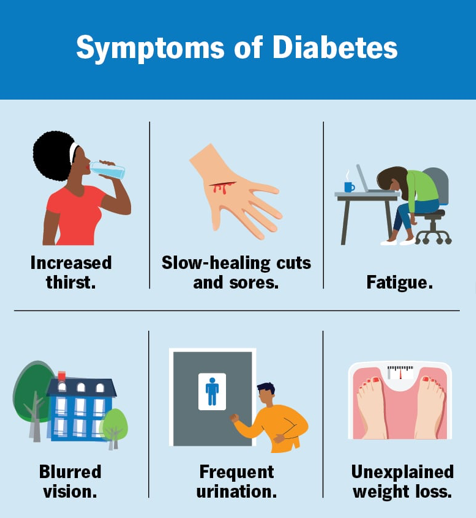Diabetic Care

Our staff pharmacists certified to deliver the CDC recognized National Diabetes Prevention Program.
Consultations include lifestyle change recommendations to prevent or delay the onset of type 2 diabetes in patients with prediabetes.
Instruction includes education for improved healthy eating, increased physical activity, and stress management.
Studies have shown that making modest behavior changes helped patients with prediabetes lose 5-7% of their body weight and reduce their body weight and reduce their risk of developing type 2 diabetes by 58% (70% for people> 60 yo)
https://www.cdc.gov/diabetes/prevention/staffing-training.htm
Call us today for more information or scheduling!
What You May Not Know About Diabetes
Author: Camryn Zornes, Health Educator, Lawrence County Health Department
The month of November is recognized as American Diabetes Month. Diabetes remains one of the most prevalent chronic diseases in the world and currently the eighth most common cause of death in the U.S.1 This chronic condition is a pertinent health concern in Lawrence County with 13.4% of our population having been diagnosed compared to the national average of 11.3%.2 So, how exactly does diabetes affect health? Diabetes impairs how glucose, one of our body’s energy sources, is processed. Type 1 Diabetes is a condition that triggers the body to attack insulin-producing cells, which causes a lack of insulin necessary to regulate blood sugar.1 This condition is autoimmune and not caused by lifestyle factors. Those with Type 1 Diabetes must have regular insulin intake through injections or a pump. There are no known ways to prevent Type 1 Diabetes.2
Type 2 Diabetes is a chronic condition affected by lifestyle factors such as lack of exercise, unhealthy eating, smoking, and even medications, and can be prevented in most cases. An estimated 9 out of every 10 cases of Type 2 Diabetes in the United States can be prevented.3 However, there are populations at greater risk of developing Type 2 Diabetes, such as women with polycystic ovary syndrome (PCOS), and men, despite their lifestyle. Women with polycystic ovary syndrome (PCOS) can also develop insulin resistance, thus more susceptible to developing Type 2 Diabetes.4 Men are also more likely to develop Type 2 Diabetes than women, which could be due to higher fat distribution to the stomach, the type of fat most associated with diabetes risk. The infographic below shows possible symptoms of Type 1 and Type 2 Diabetes.
Source: https://my.clevelandclinic.org/health/diseases/7104-diabetes

The intensity of symptoms can differ and are typically more apparent in those with Type 1 Diabetes. Those with Type 2 Diabetes may not experience symptoms, so having your blood sugar regularly checked is key to prevention.5
Type 2 Diabetes can also cause health issues such as cardiovascular disease, kidney disease, vision loss, and nerve impairment.6 But, with the right care, many of these health problems can be prevented. Current data and research show there are more factors that contribute to diabetes risk besides lifestyle choices; these include social determinants of health such as socioeconomic status, the overall environment, education level, and healthcare access and quality.7 Yet there remains a stigma surrounding those with diabetes that stems from the idea that people are in control of all factors that led to their diagnosis. This stigma may hinder those with genuine health concerns in receiving the care they need, especially for those who are overweight or obese, or have other chronic health problems.
Recognition and awareness of the social determinants of health as they relate to diabetes is important for improving care and knowing the risks associated with certain aspects of one’s lifestyle which may or may not be in his/her control. Income, healthcare access, the environment, culture, and social context all impact our risk for developing Type 2 Diabetes. Those with lower incomes may experience less access to food, healthcare, stable housing, and transportation, all of which affect overall health. The median household income is Lawrence County is $48,947, significantly lower than the national median of $74,580.8 This income gap may put our citizens at higher risk for developing Type 2 Diabetes. Inadequate healthcare access is also a burden on health – lack of insurance, distance to a healthcare facility, and even lack of internet access for telehealth services are all barriers to care for those in our community. The environment, or the area in which we live, is also very important to our health. If our close environment is unsafe, does not allow opportunities for physical activity, or does not have many places to purchase healthy foods, a healthy lifestyle is unlikely to be fostered.9 An abundance of fast-food restaurants, citizens within proximity to convenience or dollar stores, and a limited number of grocery stores or farmers markets selling fresh produce can all inhibit healthy dietary choices.
Culture also influences our diet, physical activity, and how we utilize healthcare. The typical Appalachian diet consists of high levels of sugar, fat, and sodium, which can lead to the risk of developing Type 2 Diabetes. Substituting whole grain breads for refined grain white breads, swapping whole milk and dairy products for 1% or skim, steaming or baking foods instead of frying, and adding more fruits and vegetables to your diet are all ways to improve your diet and overall health. Social and community context, which encompasses where we live, work, and worship and our social support systems such as families, friends, and other community members, can all affect our overall health and diabetes risk.9 Living in a community that does not prioritize health or a person not having a strong social support system can lead to unhealthy lifestyle choices and poor mental health. In a 2015 study, social isolation was shown to affect physical health as much as alcohol use disorders or smoking 15 cigarettes daily.10 Fostering strong relationships and maintaining a healthy support system are protective factors against health risks.
Despite many social factors contributing to diabetes risk, recognizing the lifestyle factors that can prevent your risk for diabetes is essential. Being physically active for at least 150 minutes a week, eating a diet rich in vegetables, fruits and whole grains, avoiding or quitting smoking, and developing behaviors to reduce stress are all ways in which one can lessen their risk of Type 2 Diabetes.11
For those who have been diagnosed with prediabetes or are at high risk for developing diabetes, Coal Grove Pharmacy is partnering with Marshall University to introduce the CDC’s National Diabetes Prevention Program to our community in March 2024. Coal Grove Pharmacy is one of only 46 CDC recognized facilities in Ohio offering the year long program that focuses on healthy lifestyle changes to lower the risk of developing Type 2 Diabetes. For more information, call (740) 533-2479.
Community Resources for those living with Type 2 Diabetes:
King's Daughters Medical Center
Program Name: KDMC Diabetes Education Center
Address: 2201 Lexington Avenue, Ashland, Kentucky 41101
Phone: 606-408-1540
Marshall Internal Medicine
Program Name: Chertow Diabetes Center
Address:1249 15th St., Huntington, West Virginia 25701
Phone: 304-691-1660
St. Mary's Medical Center
Program Name: Outpatient Diabetes Self-Management Education Program
Address: 2900 First Avenue, Huntington, West Virginia 25702
Phone: 304-526-8364
Southern Ohio Medical Center
Program Name: Diabetes Education Program
Address: 1805 27th Street, Portsmouth, Ohio 45662
Phone: 740-356-2627
CenterWell Home Health
Program Name: Huntington, WV
Address: US-60 Ste A, Ona, West Virginia 25545
References
- Centers for Disease Control and Prevention. (2023, September 5). What is Diabetes? https://www.cdc.gov/diabetes/basics/diabetes.html
- Map of Diagnosed Diabetes Prevalence, 2020. Rural Health Information Hub. (n.d.). https://www.ruralhealthinfo.org/charts/37?state=OH
- Harvard University School of Public Health. (2021, March 2). Simple Steps to Preventing Diabetes. The Nutrition Source. https://www.hsph.harvard.edu/nutritionsource/disease-prevention/diabetes-prevention/preventing-diabetes-full-story/#:~:text=The%20good%20news%20is%20that,heart%20disease%20and%20some%20cancers.
- The Moore Institute. (n.d.). The Social Determinants of Diabetes - Diet and Exercise are Only Part of the Issue. Oregon Health and Science University. https://www.ohsu.edu/school-of-medicine/moore-institute/social-determinants-diabetes
- Diabetes. Cleveland Clinic. (n.d.). https://my.clevelandclinic.org/health/diseases/7104-diabetes
- Centers for Disease Control and Prevention. (2023, April 18). Type 2 Diabetes. https://www.cdc.gov/diabetes/basics/type2.html#:~:text=Eventually%20your%20pancreas%20can’t,vision%20loss%2C%20and%20kidney%20disease.
- Clark, M. L., & Utz, S. W. (2014). Social Determinants of Type 2 Diabetes and Health in the United States. World Journal of Diabetes, 5(3), 296. https://doi.org/10.4239/wjd.v5.i3.296
- United States Census Bureau. (n.d.). QuickFacts Lawrence County, Ohio. https://www.census.gov/quickfacts/fact/table/lawrencecountyohio/PST045222
- Healthy People 2030. (n.d.). Social Determinants of Health. Health.gov. https://health.gov/healthypeople/priority-areas/social-determinants-health
- Holt-Lunstad, J., Smith, T. B., Baker, M., Harris, T., & Stephenson, D. (2015). Loneliness and social isolation as risk factors for mortality. Perspectives on Psychological Science, 10(2), 227–237. https://doi.org/10.1177/1745691614568352
- How You Can Prevent Chronic Diseases. Centers for Disease Control and Prevention. (2023, October 26). https://www.cdc.gov/chronicdisease/about/prevent/index.htm
